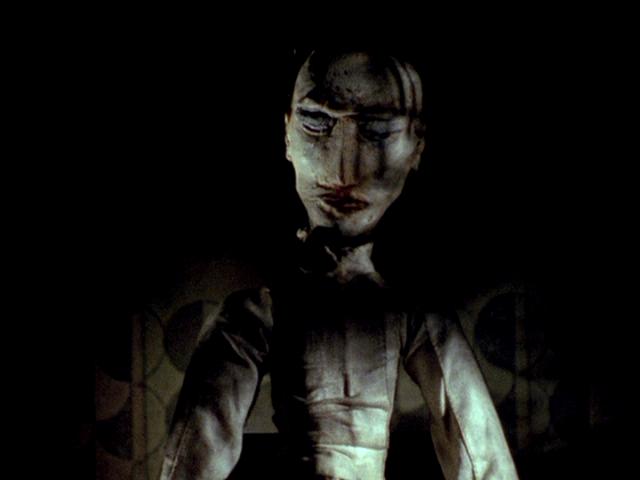
Figure 1. The Brothers Quay
The Brothers Quay illustrate a very disturbing scene with the ambiguous undertones from influences such as Jan Svankmajer. One cannot help but notice the desolate destruction as if portrayed in a back alley, the crafted toys focus on gestural animation but every tiny detail is considered conjuring a haunting image for all.
Best known for:
•Their dark moody atmospheres & disassembled puppetry
•Animated Feature “Street of Crocodiles”
•Animated Feature “Nocturna Artificialia”
•Live Action Film “Institute Benjamenta”

Figure 2. Nocturna Artificialia
The Brothers Quay started of their careers as illustrators graduating from the Philadelphia College of Art. They moved on to making animated films when receiving a scholarship to the Royal College of Art London. While in London they got to work on their initial animated shorts which were mostly lost their memorable short at the time was “Nocturna Artificialia” an enigmatic story told in chapters each separated by title cards. What is probably most memorable of the Quays work is their attention to detail in their stylistic dreary sets. Ewa Mazierska of Screen online observes:
“The Quays are renowned for their craftsmanlike methods and their unusual sources of inspiration. Apart from their puppets, which typically look like old dolls abused by many generations of children, they construct their own sets, arrange the lighting, and operate the cameras”. (Mazierska: 2003)The Quays work aspires to the stop motion medium with characters reattaching themselves in front of the audience in a dismal post apocalyptic setting. The sadness is best described by the setting while the fear is uncannily provided by the old beaten dolls, some with organic counterparts. The Quay’s ability to stage a small scene as though it is a life sized epic is probably the most influential aspect of their work. No detail is taken for granted and serves a key purpose to their narrative & influential goal.

Figure 3. Institute Benjamenta
Perhaps what is most fascinating is the Quays ability to alter the requirements of their narrative, distorting & shifting its will to evoke further insecurities from the viewing audience. It is the Quays goal to create a sort of suspension that defies realty not that much unlike a dream state. People can relate to the fictitious worlds of the Quay even if it is sometimes on the realm of the nightmare as opposed to the dream. Still one cannot take away their achievements, to create a purposeful image blurring the edges from dream from logic. Gale Cengage of Enotes observes:
“To an even greater degree than many of their literary influences, the Quays eschew linear storytelling for the evocation of intense psychological states by means of oneiric and obliquely sinister images accompanied by provocative sounds and music”. (Cengage: 1997)The Brothers Quay tend to tie the art of Pathology to their work focusing on its grotesque consequence. Their work borders on the fetish at certain points (e.g. topless dolls all posed in crude demeanour). The realities portrayed in their work symbolise a brittle truth which is somewhat archaic leaving one in a state of depression. The Quays music only attributes to the image of the depressive & fearful without answering too many questions imposed by the oneiric narrative. However, un-nerving the Quay’s work is inspiring expressing great attention to detail & a great sense of filmic exposure.

Figure 4. Street of Crocodiles
The Quay’s work is surreal providing subtle undertones that link to cultural reality it is only due to their dire need to explain the distressed that make certain themes ideal. Their most famous animated short “Street of Crocodiles” is a testament to their skill set locking audiences into a frozen half made world unparallel to time itself. Everything feels distorted as the ticking clock remains dormant with its fleshy counterpart replacing the clockwork interior. Screws come to life and start dancing as if in a crazed ballet before winding themselves back into the wooden floor. The questions are rampant but so are the audiences need to speculate what the narrative means to them. Alan Schwartz of the European graduate school observes:
“...their most famous work to date, Street of Crocodiles is a twenty-one minute animation film which evokes pre-war Poland, provincial and mystical, connected to the traditions of history before the destruction of the German war machine rolled across it”. (Schwartz: 2003)The Brothers Quay exaggerate the cultural history of the world in their works capitalizing on a dream state narrative that can either birth feelings of empathy or the uncanny. To ask the Quays for their testament to the study of psychology their influences can be summed up to the forms of the fetish or pathology. From this one can only draw the conclusion that their work suggests deeper meaning, a bitter truth that can be understood or discarded. From their exploits one would have to argue that their understanding of the Uncanny would have to be another undertone of their work due to the human psyches need to discard a familiar unfamiliar much like Jan Svankmajer before them.
List of Illustrations
Figure 1. The Brothers Quay. (com) [Online image]. At: http://twitchfilm.com/news/BrothersQuay.gif (Accessed on: 21/03/12)
Figure 2. Nocturna Artificialia. (com) [Online image]. At:
http://www.dvdbeaver.com/film2/DVDReviews30/a%20phantom%20museums%20quay%20shorts/nocturna%20artificiala%202.jpg (Accessed on: 21/03/12)
Figure 3. Institute Benjamenta. (com) [Online image]. At: http://verdoux.files.wordpress.com/2009/06/institute-benjamenta-still-b.jpg
(Accessed on: 21/03/12)
Figure 4. Street of Crocodiles. (com) [Online image]. At: http://asifa.net/wp-content/images/50x50/The%20Street%20of%20Crocodiles.jpg
(Accessed on: 21/03/12)
Bibliography
Mazierska, Ewa. (2003) Quay, Brothers (1947-). At: http://www.screenonline.org.uk/people/id/498256/
(Accessed on: 21/03/12)
Cengage, Gale. (1997) the Brothers Quay Criticism. At:
http://www.enotes.com/brothers-quay-criticism/brothers-quay (Accessed on: 21/03/12)
Schwartz, Alan. (2003) Stephen Quay and Timothy Quay - Biography. At:
http://www.egs.edu/faculty/stephen-timothy-quay/biography/ (Accessed on: 21/03/12)

No comments:
Post a Comment